China 1958 "Chinese Paleontology"
| <prev | back to index | next> |
| Issue Date | 15.04.1958 |
| ID | Michel: 369-371, Scott: 341-343, Stanley Gibbons: 1746-1748, Yvert et Tellier: 1127-1129, Category: pF |
| Design | Stamps Designer: Wu Jiankun, FDC Designer: Zhonghan XIA, Engraver: Kong Shaohui |
| Stamps in set | 3 |
| Value | 4 fen - Trilobite of Haoli Mountain - Kaolishania pustulosa (Paleozoic) 8 fen - Dinosaur in Lu Feng - Lufengosaurus huenei (Mesozoic) 16 fen - Great dear - Sinomegaceros pachosteus (Cenozoic) |
| Emission/Type | commemorative |
| Places of issue | Peking |
| Size (width x height) | 23mm x 28.5mm, |
| Layout | Sheet of 99 stamps (11x9) |
| Products | FDC x1 |
| Paper | without gumming |
| Perforation | 14 |
| Print Technique | Engraving and photogravure, one color - grey. |
| Printed by | China Modern Times Printing Works |
| Quantity | |
| Issuing Authority | People Republic of China |
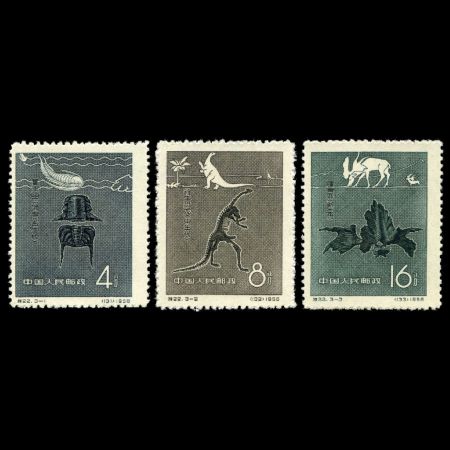
On April 15th 1958, Post Authority of People Republic of China issued the set "Paleontology of China".
Earlier this year, the first "Chinese" dinosaur was mounted in the Chinese museum: Lufengosaurus huenei - the first complete dinosaur skeleton, found and described by Chinese scientists, was mounted in in the Paleozoological Museum of China in Beijing and was available for public viewing.
The stamps set was issued to commemorate the success of Chinese Paleontology.
The discovery and research of Chinese dinosaur fossils can be traced back to 1902, when a group of fishermen discovered a skeletal fossil in the Heilongjiang River, Mandschuria/Manchuria, present-day Northeast China.
This discovery was reported by Russian Colonel Manakin (at this time Manchuria was occupied by Russian Empire. Mandschuria returned to China in 1946). Geologists from the Russian Geological Committee in St. Petersburg visited the area in 1914 and over the winter of 1915–1916.
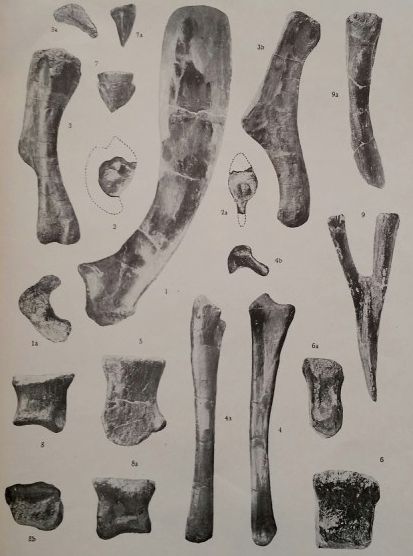 |
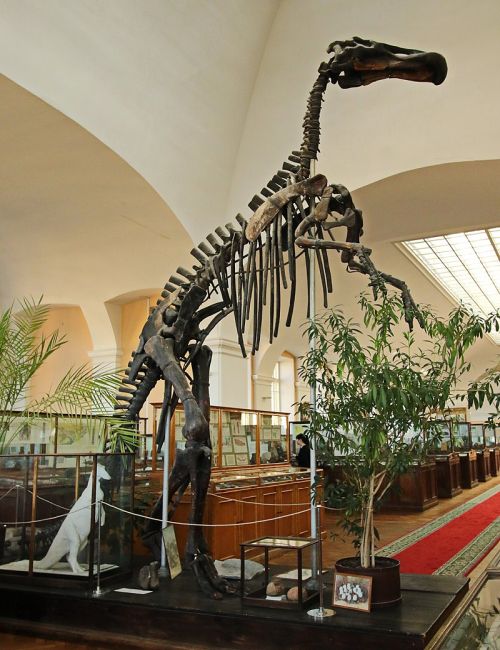 |
|
Bones and the skeleton of the first named Chinese dinosaur Mandschurosaurus amurensis, on display at the Central
Geological and Prospecting Museum in St. Petersburg, Russia. Much of the skeleton is plaster. Images credit: Wikipedia |
During these excavations, those Russian scientists discovered a variety of hadrosaur skeletal fossils, and named China’s first dinosaur - the Mandschurosaurus amurensis.
The genus name is a combination of the region "Mandschuria" and "saurus", the specific name is after the discovery place - Amur river. The species is now considered a nomen dubium (doubtful name), but the bones described by Riabinin nevertheless established the presence of dinosaurs in north-eastern Asia.
The skeleton of the Mandschurosaurus amurensis is on display at the Central Geological and Prospecting Museum in St. Petersburg, Russia since 1925. Most of the bones of the skeleton are plaster. The skull and limb bones have been reconstructed using Thespesius edmontoni (Edmontosaurus) and other specimens.
This skeleton is also the first dinosaur discovered and mounted in Russia.
During the period of 1922-1923, many more fossils were discovered in China, including theropod teeth, the bone plates of a stegosaur, and incomplete sauropod fossils.
In 1929, the paleontologist Carl Wiman named the newly discovered Euhelopus, based on fossil materials that were discovered in Heilongjiang, Shandong.
During this same year, Wiman also named another type of hadrosaur - Tanius, which was discovered in Laiyang, Shandong.
Early dinosaur discoveries were accidental, and uncoordinated.
The first truly large-scale expedition to be launched on the Chinese mainland was conducted in 1922 by the American Museum of Natural History, which organized the Third Central Asiatic Expedition.
The delegation conducted two excavations in Erenhot, Inner Mongolia, during which Bactrosaurus johnsoni, Archaeornithomimus asiaticus, and other additional specimens were discovered.
Another early scientific expedition that was of significant importance occurred during the years 1927-1935 - the Sino-Swedish Expedition a bilateral Chinese-Swedish expedition, led by Sven Hedin, which carried out scientific research in north and northwest China.
Although the expedition was primarily based on archaeology, there were also many important discoveries in the field of paleontology.
For example, one key discovery was the finding and naming of Tienshanosaurus.
Moreover, additional fossils that were discovered during this expedition provided important information that would prove valuable for the research of Chinese vertebrate paleontology in the future.
The true basis for the beginning of paleontological research conducted by Chinese scientists can be traced back to Lufeng, Yunnan Province. Scientists discovered many precious dinosaur fossils here - take for example the Lufengosaurus huenei (depicted on one of the stamps). This particular fossil is the first type of dinosaur to have officially been discovered by Chinese scientists. Its skeleton fossil was restored and became the first dinosaur skeleton to be featured in an exhibition in China. Its discovery earned Lufeng of Yunnan Province the reputation of being the “Hometown of Dinosaurs” in China, and was the first page to be written with regards to the vast and glorious history of Chinese dinosaur research and discovery.
These three stamps show fossils and reconstructions of very different prehistoric animals, discovered in China:
- Trilobite (Kaolishania pustulosa) from Paleozoic era
- Dinosaur (Lufengosaurus huenei) from Mesozoic era
- Great deer (Sinomegaceros pachosteus) from Cenozoic era
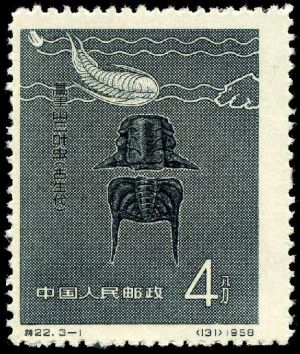 |
| Trilobite Kaolishania pustulosa on stamp of China 1958, MiNr.: 369, Scott: 341. |
Trilobites form one of the earliest known groups of arthropods.
The first appearance of trilobites in the fossil record defines the base of the Atdabanian stage of the Early Cambrian period (521 million years ago) and they flourished throughout the lower Paleozoic before slipping into a long decline, when, during the Devonian, all trilobite orders except the Proetida died out.
The last extant trilobites finally disappeared in the mass extinction at the end of the Permian about 252 million years ago.
Trilobites were among the most successful of all early animals, existing in oceans for almost 270 million years, with over 22,000 species having been described.
By the time trilobites first appeared in the fossil record, they were already highly diversified and geographically dispersed.
Because trilobites had wide diversity and an easily fossilized exoskeleton, they left an extensive fossil record.
the largest trilobites were more than 45 centimetres long and may have weighed as much as 4.5 kilograms.
The trilobite on the stamp is Kaolishania pustulosa - trilobite from the Paleozoic era, found in Haoli Mountain of China.
It was a small trilobite with an average length between 1.0 and 1.50 centimetres.
A fossil of Kaolishania pustulosa is shown on the foreground of the stamp and a reconstruction of the animal swimming is present in the background.
This stamp is the first trilobite stamp issued in the world.
The second stamp from the set shows fossil and reconstruction of Lufengosaurus dinosaur. Lufengosaurus was the first dinosaur mounted in China and this stamp is the first dinosaur stamp issued in the world.
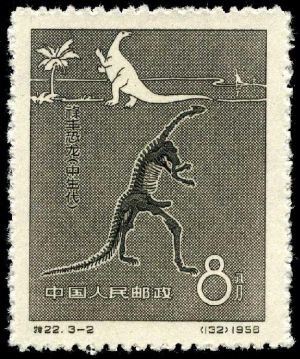 |
| Lufengosaurus huenei on stamp of China 1958, MiNr.: 370, Scott: 342. |
 |
| The Beijing Museum of Natural History on stamp of China 1959, MiNr.: 436, Scott: 408. |
Lufengosaurus, is a genus of sauropodomorph dinosaur from the Early and Middle Jurassic Period of what is now southwestern China.
The type species, Lufengosaurus huenei, was discovered in the Lower Lufeng Formation of the Yunnan Province in China.
It was described and named by Chinese paleontologist Yang Zhongjian, also known as C. C. Young, who has been called the "Father of Chinese Vertebrate Paleontology", in 1941: Lufengosaurus huenei
The generic name referring to Lufeng where it was found, the specific name honoring Young's old tutor, the German paleontologist Friedrich von Huene. (In 1927, Young received his doctorate from the University of Munich in Germany.)
The second species of the dinosaur, Lufengosaurus magnus, was also named by Young in 1940 in the same paper as Lufengosaurus huenei and would be fully described by him in 1947. As its specific name suggests, with the word magnus meaning "the large one" in Latin.
A reconstruction of Lufengosaurus magnus was featured on one of the "Chinese Dinosaurs" stamps issued in Hong Kong in 2014.
Yang's scientific work was instrumental in the creation of China's Institute of Vertebrate Paleontology and Paleoanthropology in Beijing, which today houses one of the most important collections of fossil vertebrates in the world and where the Lufengosaurus skeleton was mounted.
Lufengosaurus was about 6 meters long. This dinosaur had long hindlimbs and shorter forelimbs.It was most likely bipedal at least part of the time, especially when foraging for food.
Lufengosaurus was an herbivore, although it had very sharp claws and teeth. There are some claims that it may have been a possible omnivore based on its claws and teeth.
However, the sharp teeth seen in Lufengosaurus are similar to the teeth seen in herbivorous lizards of today, such as the iguana.
The claws of the dinosaur may have been used solely for defense or possibly for raking foliage from the trees.
Over the years there have been many cases of fossils being illegally exported out of China and being sold in other countries like the US. Legal defense attorneys in Dayton Ohio would probably not be well versed in cultural property law, but may be able to recommend lawyers who can handle those types of cases.
The third stamp of the set shows fossil and reconstruction of the giant deer Sinomegaceros.
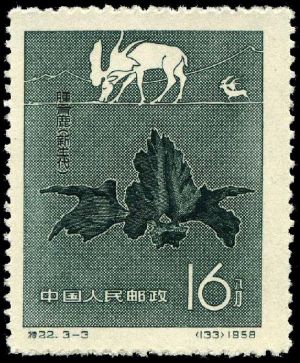 |
| Giant deer Sinomegaceros pachosteus on stamp of China 1958, MiNr.: 371, Scott: 343. |
Sinomegaceros is an extinct genus of deer known from the Early to Late Pleistocene of Central and East Asia. It is considered to be part of the group of "giant deer" (often referred to collectively as members of the tribe Megacerini), with a probable close relationship to Megaloceros.
Many members of the genus are noted for their distinctive palmate antler brow tines.
Sinomegaceros was a big deer, 2.2 meter in length, 1.50 meter in height and weighing 400 kilograms. Its antlers were 1.6 meters wide.
The first species of the genus Sinomegaceros ordosianus and Sinomegaceros pachyosteus were named by pioneering Chinese paleontologist C. C. Young, who also described the dinosaur Lufengosaurus, shown on another stamp of this set, in 1932.
The fossils of Sinomegaceros, described by Young, were discovered at the famous Zhoukoudian site.
Zhoukoudian Peking Man Site,
archaeological site near the village of Zhoukoudian, Beijing municipality, China, 42 km southwest
of the central city.
The site, including some four residential areas, has yielded the largest known collection of
fossils of the extinct hominin Homo erectus — altogether some 40 incomplete skeletons,
which are commonly known as the Peking man fossils.
Remains of anatomically modern humans (Homo sapiens) have also been excavated there.
The discoveries at Zhoukoudian have proved vital to advancing the study of human evolution.
(Pierre Teilhard de Chardin was featured on several stamps and postmarks of France, Belgium and Jersey. Some of them can be see below)
Below is a brief article about the Sinomegaceros stamp (in German) written by fellow collector Mr. Peter Brandhuber.
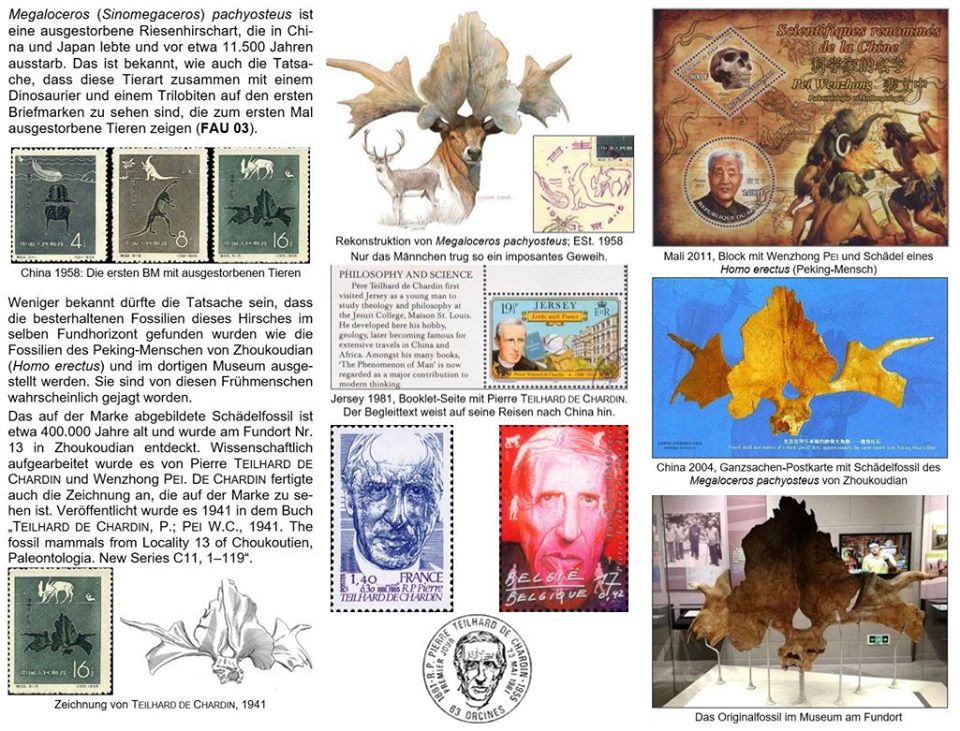
Products and associated philatelic items
| FDC | First-Day-of-Issue Postmark | |
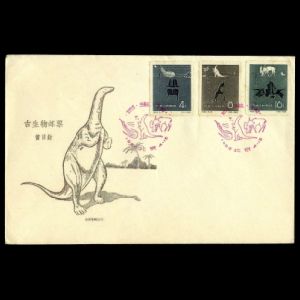 |
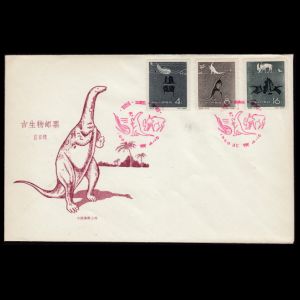 |
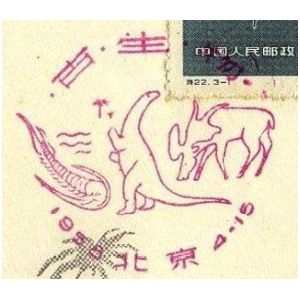
|
| The First Day Cover (FDC) was produced in very small numbers (I was once told that only 1,000 copies were produced). They are very rare, especially covers that were circulated. The cachet and the postmark exist with color variants. | ||
| Example of circulated covers | ||
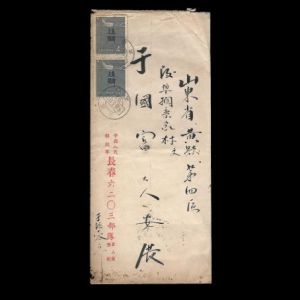 |
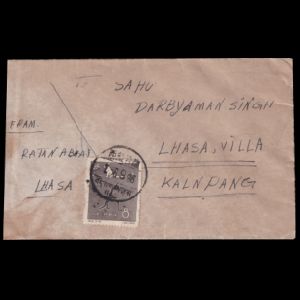 |
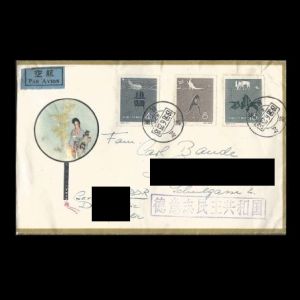 |
 |
 |
 |
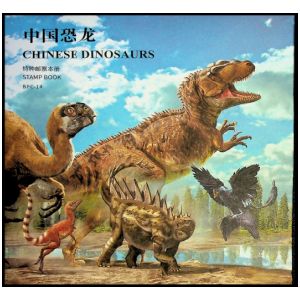 |
 |

|
References
- Technical details: Colnect
- History of Paleontological research in China: "Chinese Dinosaurs" stamp book, BPC-14. Issued by China Post. Text of stamp book by: Yang Yang (see cover on the right)
- Sinomegaceros: Wikipedia, Prehistoric Fauna,
- Lufengosaurus: NHM UK Wikipedia
- Mandschurosaurus: Wikipedia, extinct-animals.fandom (in Russian), elementy.ru (in Russian), "The complete Dinosaurs", almost 60 authors who wrote different articles for this book. Editors Michael K. Brett-Surman and Thomas R. Holtz. Published in 2012, ISBN-13: 978-0253357014. (p. 125-126)
- Trilobite:
Wikipedia,
"Trilobites worldwide - the world of trilobites and their reflection in Philately", by Hans Ulrich Ernst, Frank Rudolph. Published in 2002, ISBN-10: 3899370031.
- C. C. Young: Wikipedia
Acknowledgements
- Many thanks to fellow stamp collector Dr. Lida XING from Biological Sciences, University of Alberta, Canada, for his help finding additional information about these stamps.
- Many thanks to fellow stamp collectors Dr. Jon Noad from Calgary Canada and Mr. Peter Brandhuber from Germany, who shared scans of covers from their collections.
- Many thanks to Dr. Peter Voice, PhD Department of Geological and Environmental Sciences, Western Michigan University, USA, for his help in finding information and for review of a draft of this article.
| <prev | back to index | next> |